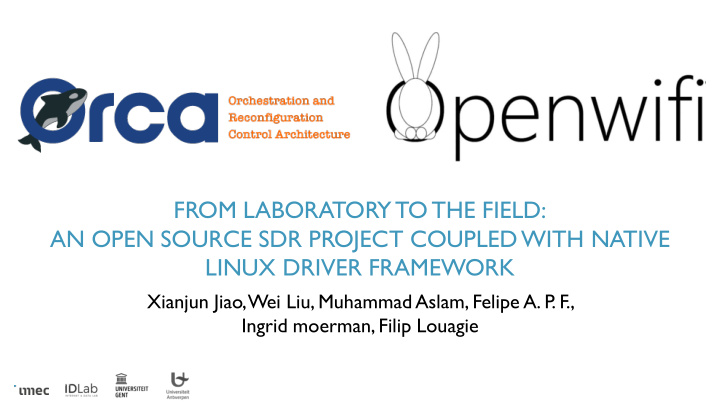



FROM LABORATORY TO THE FIELD: AN OPEN SOURCE SDR PROJECT COUPLED WITH NATIVE LINUX DRIVER FRAMEWORK Xianjun Jiao, Wei Liu, Muhammad Aslam, Felipe A. P . F., Ingrid moerman, Filip Louagie
OPENWIFI FIRST OPEN SOURCE FULL STACK REAL-TIME WI-FI Motivation Project positioning and technical information License consideration and collaboration Development schedule
FIRST OPEN SOURCE FULL STACK REAL-TIME WI-FI ON FPGA WITH EMBEDDED ARM AND LINUX MOTIVATION You have a good idea to improve Wi-Fi: New antenna system that need to work tightly with baseband control • Still no ideal SDR option for Wi-Fi research… New RF front-end that need to work together with baseband • • New baseband waveform/algorithm for new scenario/applicaiton • New high and low MAC to improve QoS And want to demonstrate your idea in the real world. MAC philosophy is so different: 10us SIFS (Wi-Fi) vs 4ms HARQ (LTE) Not like pure SW implementation of LTE (srsLTE, OA), Wi-Fi Option3: implementation needs HW acceleration, which is more challenging! Option1: Learn special language and Dig into commercial chip use special HW (not cheap) Option5: black-box. Some reverse with special OS (Windows) – DIY… engineering. Good luck! Microsoft SORA/Ziria Option4: Option2: Use some blocks from Buy expensive proprietary Gnuradio or papers. Never SDR HW/SW design with get end-to-end. Most of limitations. Like NI, WARP them work in sniffing mode.
FIRST OPEN SOURCE FULL STACK REAL-TIME WI-FI ON FPGA WITH EMBEDDED ARM AND LINUX Full stack SDR project survey: Free Open source The project positioning/benefits: Non Free/Open FPGA (PL of Xilinx Zynq SoC) High performance, low latency Upper layer ASIC friendly (in case people want ASIC) WiFi: Ziria Microsoft Fast/in-field iteration, bug-fix, update LTE/5G: srsLTE ARM (PS of Xilinx Zynq SoC) X86 CPU WiFi: Tick, Linux wifi driver LTE/5G: Open Air intf Low power, low cost +Linux WiFi/LTE: NI, NS3 in Linux Embedded/portable friendly LTE/5G: Amarisoft Very big processor eco system Our project: Linux ARM Very big community WiFi: Embedded Linux +Linux Very rich software and kernel components Embedded friendly MicroBlaze PHY+ WiFi: Mango Low cost Bare metal low MAC High secruity – open sourc code (hackers are X86 CPU FPGA staring on it)
IMPLEMENTATION ARCHITECTURE AND FEATURES Basic features (802.11a/g; 802.11n 20MHz MCS 0~7) Ad-hoc mode AP mode Special tools Station mode Special features (Survey/feedback in community/conference) IQ sample and spectrum sensing capability without interrupt Kernel communication space TAISC (Flexible MAC engine) to ease MAC development Possible future features Access deep PHY information: channel response, etc. Multi antenna support: direction finding; beamforming; MIMO Multiple virtual interfaces/slices from one PHY Driver Linux 802.11p DSRC for V2V, most popular V2V standard 802.11ah FPGA 802.11ax RF front-end Community input
WHAT WILL BE AVAILABLE OUT OF BOX Ours: images and source code Precompiled images for specific hardware platform Special tools Linux image FPGA image Source code of software/FPGA components Special tools in user space to access special feature in driver and FPGA Kernel Linux driver space FPGA design Yours: Hardware platform Zedboard+ad9364 (720 euro) ADRV9364-Z7020 SOM + ADRV1CRR-BOB carrier (750 euro) Driver Linux ADRV9361-Z7035 SOM + ADRV1CRR-BOB carrier (1300 euro) Zc706/zcu102+ad9361 (3250 euro) FPGA Xxx according to community input RF front-end
OPEN SOURCE PLATFORM LEVERAGE FOR COLLABORATIONS CHOICE OF OPEN SOURCE LICENSE IS IMPORTANT Low-entry level for various users because of Open Source : Academic research partners and corresponding projects Industrial partners doing R&D Non-commercial usage (License type to be decided). For research usage without request/registration or complicated administrative procedure. Commercial usage, Support and Customization License for non-open commercial purpose Dedicated support service R&D service: adapting the implementation to customer request
POTENTIAL AUDIENCES/CUSTOMERS IN OUR MIND project users: secondary develop End use cases/market: Wireless research community: Showcase, testbeds, reports, papers PHY, MAC, network (NS3, click, etc) Wireless security: hackers Attack demos, reports, papers Wi-Fi openWRT company and hobbyist Wi-Fi router Vertical, niche: drone, factory, army . Industrial company: system integration Industrial company: developing chip Chips for phone/device/niche/etc. Internal: verification, R&D platform External customers
DEVELOPMENT SCHEDULE FIRST STABLE VERSION BY END OF THIS YEAR Ad-hoc Station AP Open source mode mode mode on github 2019 2020 March June September December January Video streaming via 1 time slice. in ORCA project review meeting
THANKS! Q&A
Recommend
More recommend